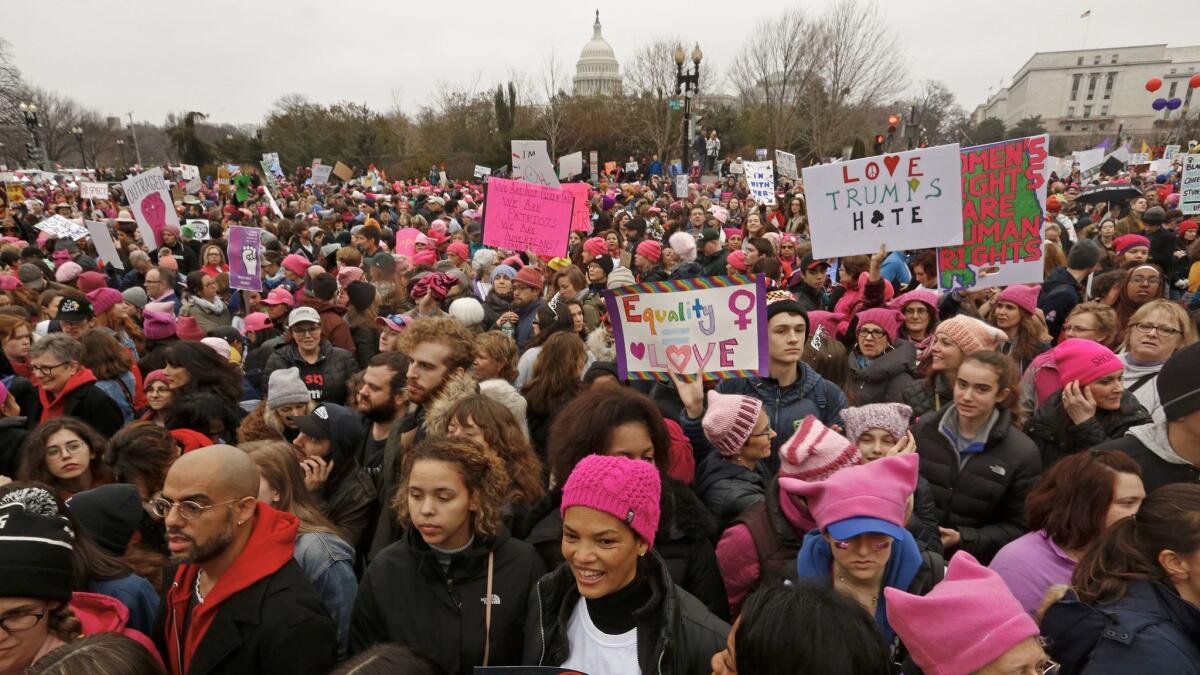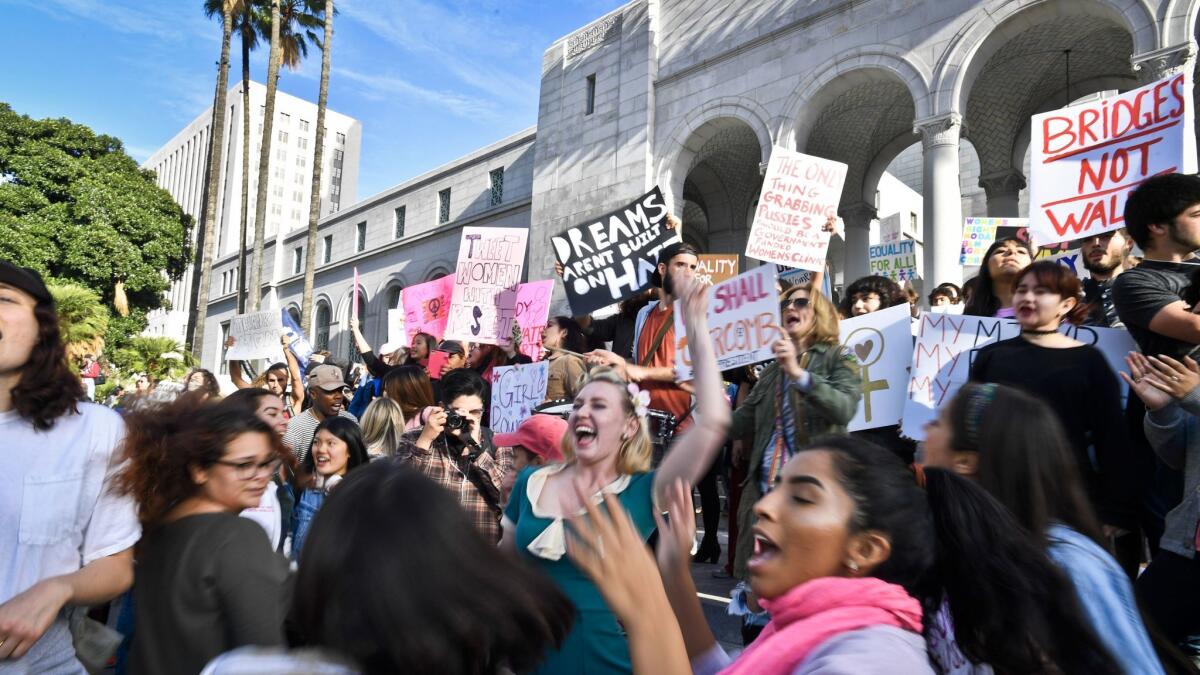Turning point, or just a day to let off steam: Where do the protesters of the Women’s March go from here?

- Share via
As millions of demonstrators marched across America, in a panoramic rebuke to the country’s new president, the interim head of the Democratic Party looked on approvingly.
“It’s a real movement — organization, resources, leaders and institutional support,” said Donna Brazile, who got her start in politics knocking on doors in her poor neighborhood outside New Orleans. “While politicians attended, they didn’t organize this event. That’s real power. Grass-roots at its core.”
But will it matter much beyond last weekend?
In the halls of Congress, in office towers and break rooms, on park benches, really anywhere two or more left-leaning activists gathered, the questions Monday were the same: Was the Women’s March on Washington and around the country the start of a history-bending political movement? Or merely a way for Trump-loathing Democrats and their allies to blow off steam in a great gust of pink-hued protest?
How celebrities at the Women’s March say they’ll reflect the change they want to see in America »
“Honestly, we’re still trying to figure that out,” said Ben Tulchin, a pollster for the insurgent presidential candidacy of Bernie Sanders. Tulchin spent the day with his 5-year-old son while his wife and 7-year-old daughter joined Saturday’s demonstration in San Francisco.
“Prior to the march, we were all trying to figure out what resistance to President Trump will look like,” Tulchin said. “Today, we’re trying to anticipate where it goes from here.”
Organizers of the protest were laying concrete plans, hoping to capitalize on the momentum before it dissipates.
Even before the marchers left Washington there were workshops, instructing women on the nuts and bolts of running for office back home. Planned Parenthood held a training session for 2,000 organizers on how to build support and fight efforts to end its federal funding.
The website promoting the march called for 10 follow-up steps in the first 100 days of the Trump administration, starting with a postcard-writing campaign directed at the U.S. Senate; it promised nine more suggestions to come.
Plans were already underway for another big protest in Washington in April, to promote continued government action to fight climate change.
“It’s absolutely critical the Women’s March not become a one-off,” said Susan Casey-Lefkowitz, a leader of the Natural Resources Defense Council, one of the chief organizers of Saturday’s protest. “The intent is that the Women’s March is really the inauguration of the defense against Donald Trump.”
For all their spectacle, however, the nationwide demonstrations cannot overcome deep divisions within the Democratic Party, which stands, for now, as the leading edge of the anti-Trump opposition.

Brazile, who has spent decades working for Democratic candidates and causes, is seen as an enemy by many of her ideological soulmates, precisely because she has spent so many years as a party operative. (Notably, she was in Europe on Saturday, watching the protests from overseas.)
The contest for her replacement as the party’s national chair has become a proxy battle between supporters of Sanders and Hillary Clinton, who continue to harbor ill will over their acrimonious fight for the Democratic presidential nomination.
Similar battles are underway to lead state parties across the country, and the bitterness among Democrats did not suddenly dissolve as a result of Saturday’s massive demonstrations. For some, the huge turnout brought sadness and angry thoughts of what might have been.
“If I spoke at any march … I would say this: ‘Being here today does not forgive you of your sins against not doing enough for Hillary Clinton,’” said Michael Trujillo, a Democratic strategist who worked for both of her presidential campaigns.
“Marching today isn’t about checking off some box” before visiting the Arts District, Trujillo went on, referring to the trendy neighborhood on the edge of downtown Los Angeles. “It’s about dedicating every Saturday to calling voters for the (2018 elections). Absent that, I guess ‘Thank you’ for the nice visuals on CNN.”
The most successful protest movements have been a culmination of years of effort and unity around a common purpose: ending the Vietnam War, promoting civil rights or, more recently, thwarting the sweeping federal healthcare law passed under President Obama.
By contrast, Saturday’s demonstrations served up a smorgasbord of political causes: the plight of Native Americans, environmental justice, reproductive rights, religious freedom, gay rights, immigration rights, gun control, education funding, and more.
The one unifying thread was opposition to Trump and Republicans who now control Congress and that, Casey-Lefkowitz insisted, “is a very, very durable” force binding Democrats and their allies and, most importantly, ensuring they stay active and engaged. “That feeling of empowerment is one that’s going to continue,” she said.
That, of course, remains to be seen.
For now, protest organizers are eager to act before the moment, and its emotional pitch, fades away.
Emily’s List, a Democratic group that supports female candidates, held a Sunday morning training session for hundreds of protesters who came to Washington, encouraging them to return home and invest their energies at the state and local levels.
“The best candidates are the ones who want to fix something, or who are mad as hell,” said Marcy Stech, a spokeswoman for Emily’s List. “Right now there’s a beautiful combination of those factors and we’re working diligently to take advantage of that.”
Times staff writer Seema Mehta contributed to this report.
ALSO
The science behind crowd counting
Madonna clarifies ‘blowing up the White House’ comment: ‘Taken wildly out of context’
Trump takes step toward reshaping U.S. trade and freezes hiring of federal workers
More to Read
Get the L.A. Times Politics newsletter
Deeply reported insights into legislation, politics and policy from Sacramento, Washington and beyond. In your inbox twice per week.
You may occasionally receive promotional content from the Los Angeles Times.











